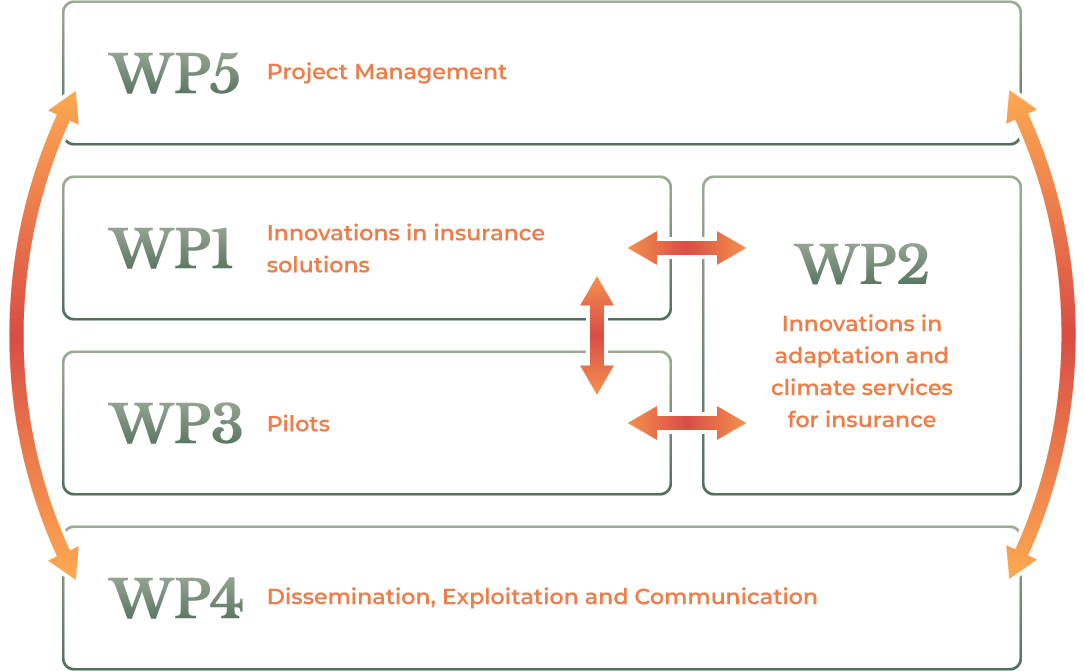
About the project
What is Climate Adaptation?
Adaptation means adjusting to both actual and
expected effects of climate change.
By adapting to the consequences of
climate change, such as extreme weather events,
wildfires and floods, we can protect ourselves and
our communities from further damages and also
benefit from possible opportunities. Adaptation is
not separate from other climate actions such as
mitigation and risk management - these are
essentially interlinked. For example, to be able to
adapt with smaller costs we must urge green
transition and mitigation worldwide.

Adaptation in general refers to adjustments in ecological, social and economic systems and it consists of groups of actions including risk reduction and risk sharing. Climate adaptation is high on the European economic and political agenda, and their strategy on adaptation has four principal objectives: to make adaptation smarter, swifter and more systemic all while boosting international action on adaptation to climate change.
The PIISA project supports climate change adaption across all policy levels and supports the Mission on Adaption to Climate Change.
Adaptation and climate risk insurance at the core of the PIISA project
It is essential for all actors to adapt to the changing
climate and reduce the climate risks that touch their
sector or sphere of life. At the moment, there is an
adaptation gap, meaning that the level of implemented
adaptation is insufficient to meet the adaptation
targets. This gap needs to be addressed. Insurance
companies can help fill the gap by encouraging insurance
users to better prepare and adapt to the changing
climate and reduce risks. This can be partially filled
by providing information and guidelines, and partially
by financial premiums for insurance users.
Insurance is a contract that allows a policyholder to
receive compensation from a provider, typically an
insurance company, for a certain loss in exchange for
the periodic payment of small amounts of money. As such,
insurance instruments allow policyholders to share some
or all of their risk with third parties, and insurance
providers to pool risks from many different
policyholders.
Climate insurance is meant to reimburse policyholders
for losses generated by natural hazards such as
cyclones, earthquakes, storms, floods and wildfires,
which are being exacerbated by climate change. Most
climate insurance products take the form of indemnity
contracts, whereby a policyholder is compensated for
material losses based on specific contractual conditions
such as deductibles or cover limits. Before a claim can
be paid, the insurance provider has to quantify the
losses, which can considerably slow down the repayment
process. Alternative types of products, such as
parametric insurance or microinsurance, have emerged in
recent years, but they are still not widely utilised.
New climate insurance products can encourage
adaptation measures
In 2011-2020, the climate insurance protection gap
worldwide amounted to 64% of total losses, with huge
disparities across regions. In the EU, it is estimated
that only 25% of losses are currently insured, with
shares as low as 5% in certain countries. Differences in
insurance penetration also exist across sectors and
hazard types.
In spite of efficient risk mitigation and adaptation
efforts, all climate risks cannot be prevented.
Insurance provides protection against so-called residual
risks. In those cases, insurance can help cover the
damages. Well-designed climate insurance products can
greatly reduce the adverse consequences of climate risks
by rapidly providing available funds for recovery and
reconstruction. This also limits the need for
governmental relief, thus mitigating economic damage.
Existing insurance products may not, however, be
sufficient for the changing conditions. New, innovative
insurance products can both encourage adaptation
measures and bring security to the policyholder. We
develop new insurance concepts or products for three
sectors: cities (considering nature-based solutions and
well-being), agriculture and forestry sectors. The PIISA
project will first pilot the concepts in the
specifically chosen locations with key stakeholders, and
then it will assess their potential for wider uptake.
What is PIISA?

PIISA stands for “Piloting Innovative Insurance Solutions for Adaptation” and is a 3-year Research and Innovation Action funded under the Horizon Europe programme within the call “HORIZON-MISS-2022-CLIMA-01”. The partnership brings together 12 organisations from 5 European countries, and will co-develop climate resilient insurance portfolios, as well as develop solutions for sharing climate-related risk and losses data. The focal sectors benefiting from the project are agriculture, forestry, cities and citizens’ well-being, tackling a host of climate enhanced hazards such as floods, droughts, forest fires, biotic risks, and various types of storms.
What is PIISA’s ambition?
PIISA aims to develop and deploy a range of insurance innovations to cover at least 50% of losses attributable to climate change effects in Europe. The project hopes to support households, firms, and public authorities to set up adaptation and create adaptation promoting conditions.


Work Packages
Innovation in Insurance Solutions
This WP reviews the current state of the market for climate risk insurance and analyses the challenges and opportunities to overcome market barriers through innovation in design and delivery of insurance products and services.
Work Package Leader :
Jaroslav Mysiak
Stefano Ceolotto
Innovations in adaptation and climate services for insurance
This WP is dedicated to co‑design, co‑develop and co‑produce climate services. As defined by WMO, a climate service is a decision aid derived from climate information that assists individuals and organizations to make climate‑informed decisions. In PIISA, WP2 transforms the needs of insurance for creating innovative products, as clarified in WP1, into enhanced data and climate indicator, e.g high‑resolution gridded data and climate indices for parametric insurance, return period services, city microclimatic solutions, etc. The solutions are co‑designed, co‑developed and co‑produced in the context of the pilots, in collaboration with WP3.
Work Package Leader :
Laura Trentini
Pilots
This WP focuses on the development of new innovative concepts, advanced products, and services through piloting The following themes will be explored in the pilots:
Pilot 2 - Addressing soil stability risks for home owner insurance holders,
Pilot 3 - Insurance Services for Agriculture,
Pilot 4 - Forest Insurances against selected biotic and abiotic risks and
Pilot 5 - Wildfire insurance enhancing adaptive actions.
Work Package Leader :
Heikki Tuomevirta
Dissemination, exploitation and communication
This WP is dedicated to communicating and disseminating the activities and results generated in PIISA to target audience as well as to promoting a dialogue with key stakeholders and exploiting the outcomes. These activities serve all other work packages.
Work Package Leader :
Kati Berninger
Project Management
This WP is responsible for administration and overall coordination of the project.
Work Package Leader :
Hilppa Gregow
-
Mikael Hildén -
Finnish Environment Institute SYKE -
Franscesco Sciascia -
Green Assicurazioni SRL - Pascal Forrer - AIAG
-
Jaakko Nuottokari -
Finnish Meteorological Institute - Roberta Boscolo - WMO
-
Vylon Ooms -
Dutch Association of Insurers -
Leigh Wolfrom -
OECD’s Directorate for Financial and Enterprise Affairs - Alessandro Bonazzi - Generali
- as well as 4 more experts.